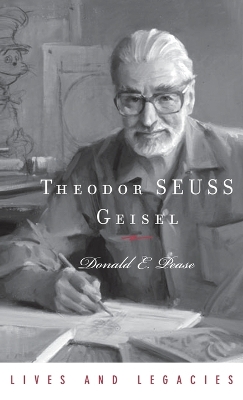Lives and Legacies
2 total works
Dr. Seuss's infectious rhymes, fanciful creatures, and roundabout plots not only changed the way children read but imagined the world. And to Think That I Saw It On Mulberry Street, Green Eggs and Ham,The Cat and the Hat, these and other classics have sold hundreds of millions of copies and entertained children and adults for decades.
After graduating from Dartmouth, Theodor Geisel used his talents as an ad-man, political provocateur, and social satirist, gradually but irrevocably turning to children's books. Theodor SEUSS Geisel tells the unlikely story of this remarkable transformation. In this compact and engrossing biography, Donald Pease reveals the evolution of Dr. Seuss's creative persona while offering an honest appraisal of his life. The book also features many of Dr. Seuss's lesser-known illustrations,
including college drawings, insecticide ads, and wartime political cartoons-all of which offer a glimpse of his early artistic style and the visual origins of the more famous creatures that later populated his children's books.
As Pease traces the full arc of Dr. Seuss's prolific career, he combines close textual readings of many of Dr. Seuss's works with a unique look at their genesis to shed new light on the enduring legacy of America's favorite children's book author.
After graduating from Dartmouth, Theodor Geisel used his talents as an ad-man, political provocateur, and social satirist, gradually but irrevocably turning to children's books. Theodor SEUSS Geisel tells the unlikely story of this remarkable transformation. In this compact and engrossing biography, Donald Pease reveals the evolution of Dr. Seuss's creative persona while offering an honest appraisal of his life. The book also features many of Dr. Seuss's lesser-known illustrations,
including college drawings, insecticide ads, and wartime political cartoons-all of which offer a glimpse of his early artistic style and the visual origins of the more famous creatures that later populated his children's books.
As Pease traces the full arc of Dr. Seuss's prolific career, he combines close textual readings of many of Dr. Seuss's works with a unique look at their genesis to shed new light on the enduring legacy of America's favorite children's book author.
Dr. Seuss' infectious rhymes, his blue-tufted, strong-willed creatures, and his knack for pithy, roundabout plots have been entertaining children and adults for decades. And as Donald Pease shows in this marvelous biography, the seemingly haphazard trajectory of Theodor Geisel's life bears a close resemblance to the zigzag plot lines of his children's books.
Here is an engaging look at a man who indeed lived a zigzag life, by turns a cartoonist, ad agency artist (for Flit bug killer), author, caricaturist, documentary-film writer and producer, political cartoonist, and editor. Pease follows Geisel's life from his childhood in Massachusetts, to his sacking from the editorship of Dartmouth's humor magazine, to the publication of And to Think That I Saw It on Mulberry Street--after 17 rejections--which finally launched him on the career for which he is best known. It was a career marked by whimsy. Geisel began work on Green Eggs and Ham, for instance, only after Bennett Cerf, his editor at Random House, wagered that he could not write a children's book that used no more than fifty different words. Geisel won, and the result was a series of works over the next ten years--How the Grinch Stole Christmas!, Yertle the Turtle, The Sneetches and Other Stories, Hop on Pop--that changed the way children everywhere learned to read. Given unprecedented access to Dartmouth's extensive Geisel holdings, Pease captures this life in full as he offers fresh insights into the sources of Geisel's creativity, from his surreal images to his anti-authoritarian stance and slapstick humor. Readers are treated to many lesser-known illustrations, such as his censored creations during college, insecticide ads, and wartime political cartoons--all of which offer a glimpse of his early artistic style and the visual origins of the more famous creatures that later populated his children's books.
Here is an engaging look at a man who indeed lived a zigzag life, by turns a cartoonist, ad agency artist (for Flit bug killer), author, caricaturist, documentary-film writer and producer, political cartoonist, and editor. Pease follows Geisel's life from his childhood in Massachusetts, to his sacking from the editorship of Dartmouth's humor magazine, to the publication of And to Think That I Saw It on Mulberry Street--after 17 rejections--which finally launched him on the career for which he is best known. It was a career marked by whimsy. Geisel began work on Green Eggs and Ham, for instance, only after Bennett Cerf, his editor at Random House, wagered that he could not write a children's book that used no more than fifty different words. Geisel won, and the result was a series of works over the next ten years--How the Grinch Stole Christmas!, Yertle the Turtle, The Sneetches and Other Stories, Hop on Pop--that changed the way children everywhere learned to read. Given unprecedented access to Dartmouth's extensive Geisel holdings, Pease captures this life in full as he offers fresh insights into the sources of Geisel's creativity, from his surreal images to his anti-authoritarian stance and slapstick humor. Readers are treated to many lesser-known illustrations, such as his censored creations during college, insecticide ads, and wartime political cartoons--all of which offer a glimpse of his early artistic style and the visual origins of the more famous creatures that later populated his children's books.

